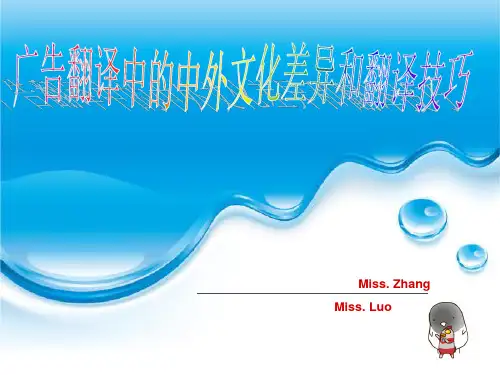中西方文化差异对广告翻译的影响 ppt课件
- 格式:ppt
- 大小:1.06 MB
- 文档页数:21


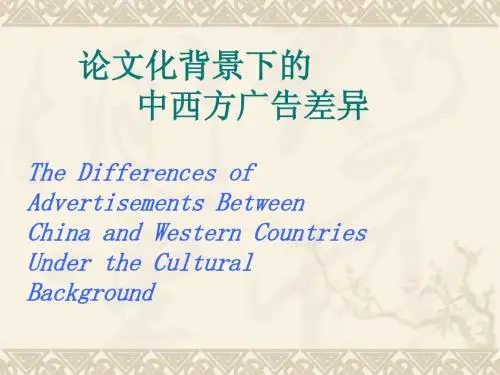
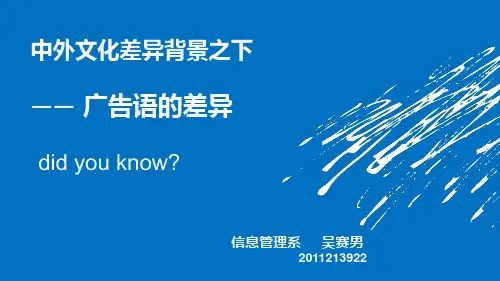
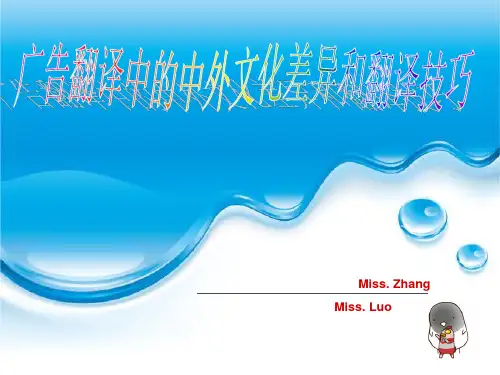
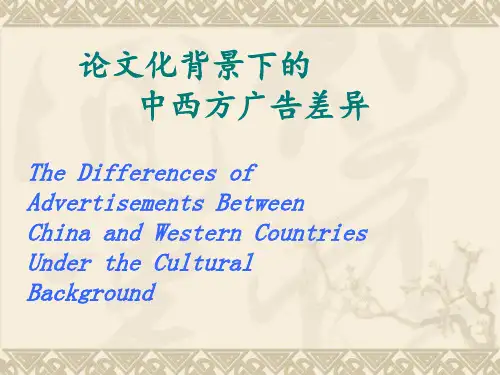
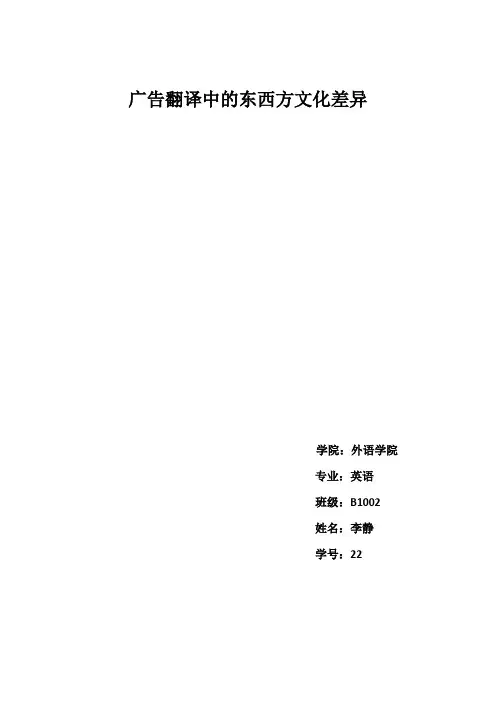
广告翻译中的东西方文化差异学院:外语学院专业:英语班级:B1002姓名:李静学号:22广告翻译中的东西方文化差异在迅猛发展的商品经济时代,广告在人们的生活中无处不在。
尤其随着对外交流的不断增加,异域广告之间的交流亦日趋频繁。
此处的异域广告不同于一般意义上的国内广告,而是一种跨越国界的商业广告,因此它将广告翻译引入到了学术界。
由于不同语言文化之间的差异,不同文化背景的人们对同一语言信息的理解也可能不同,甚至截然相反。
同样,深为某一群体喜爱和欣赏的信息未必另一文化群体会青睐。
因此广告翻译中涉及的两种文化差异相联的内容构成了翻译中既广泛又复杂的难题。
不同的国家、民族在地理环境、历史、传统、宗教、生活方式、政治制度、价值观念等方面存在着许多差异,而这些文化因素的差异往往都会体现在语言之中。
一、历史背景差异作为记录人类历史及表达人类生活和思想的工具,每种语言都有其深远的历史背景和文化内涵。
因此不同的社会背景反映在广告翻译上也有所不同。
如:日本丰田公司在中国市场的广告是“车到山前必有路,有路必有丰田车。
”这是套用了中国的一句俗语。
但在美国,他们却换成了“‘Not all cars are created equal’(并非所有的车都生而平等),因为了解美国历史的人都知道,美国《独立宣言》中的首句就是‘All men are created equal’(人人生而平等),丰田公司就是以此来表示丰田车的质量比其他的车要好。
”运用些译入语国家人们所熟知的谚语、俗语可以达到事半功倍的宣传效果。
二、语言习惯广告翻译首先要考虑到带有浓厚文化色彩的习惯用法、成语与出于寓言、典故、宗教习俗的地名与人名等,翻译时要进行调整,不可照字面直译,亦不可依照某国文化特有的说法想当然的推译,必须注意中外文化的双向交流。
比如说,我们都熟悉的“白象”电池。
该商标被译为“White Elephant”,同样为英美国家所不喜欢,因而难以成功。
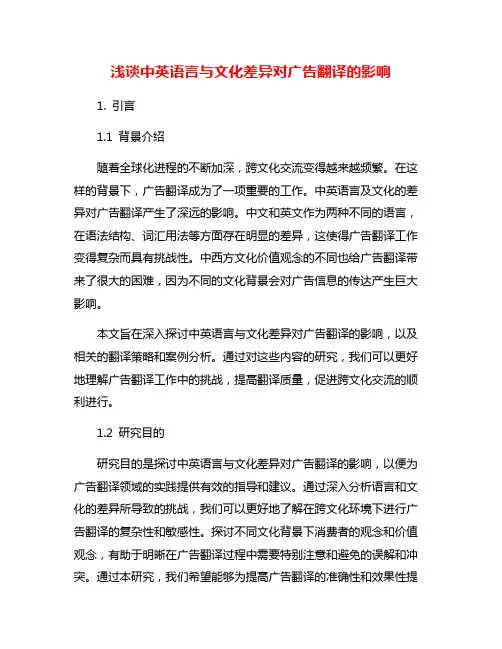
浅谈中英语言与文化差异对广告翻译的影响1. 引言1.1 背景介绍随着全球化进程的不断加深,跨文化交流变得越来越频繁。
在这样的背景下,广告翻译成为了一项重要的工作。
中英语言及文化的差异对广告翻译产生了深远的影响。
中文和英文作为两种不同的语言,在语法结构、词汇用法等方面存在明显的差异,这使得广告翻译工作变得复杂而具有挑战性。
中西方文化价值观念的不同也给广告翻译带来了很大的困难,因为不同的文化背景会对广告信息的传达产生巨大影响。
本文旨在深入探讨中英语言与文化差异对广告翻译的影响,以及相关的翻译策略和案例分析。
通过对这些内容的研究,我们可以更好地理解广告翻译工作中的挑战,提高翻译质量,促进跨文化交流的顺利进行。
1.2 研究目的研究目的是探讨中英语言与文化差异对广告翻译的影响,以便为广告翻译领域的实践提供有效的指导和建议。
通过深入分析语言和文化的差异所导致的挑战,我们可以更好地了解在跨文化环境下进行广告翻译的复杂性和敏感性。
探讨不同文化背景下消费者的观念和价值观念,有助于明晰在广告翻译过程中需要特别注意和避免的误解和冲突。
通过本研究,我们希望能够为提高广告翻译的准确性和效果性提供理论依据和实践倡导,促进不同文化之间的理解和沟通,促进全球商业和文化交流的发展。
2. 正文2.1 语言差异的影响语言差异对广告翻译的影响是非常重要的。
中英语言之间存在着差异,包括语法结构、词汇选择、句式等方面。
这些差异会导致广告在翻译过程中出现不一致、不连贯的情况,影响到广告的效果和传达信息的准确性。
中英语言的语音、语调、节奏也存在一定差异,这对广告的口语表达和语气把握都提出了挑战。
中文通常是象形文字,强调意义和内涵,而英文则更注重表达和形式,因此在翻译广告时需要考虑到这些语言特点,避免出现语言表达不准确或失真的情况。
在广告翻译过程中,语言的含蓄与直白也是一个重要的考虑因素。
中文通常更含蓄、委婉,而英文则更直接、清晰。
因此在翻译广告时,需要适当调整语言的表达方式,使之符合所处文化背景的口味和习惯。
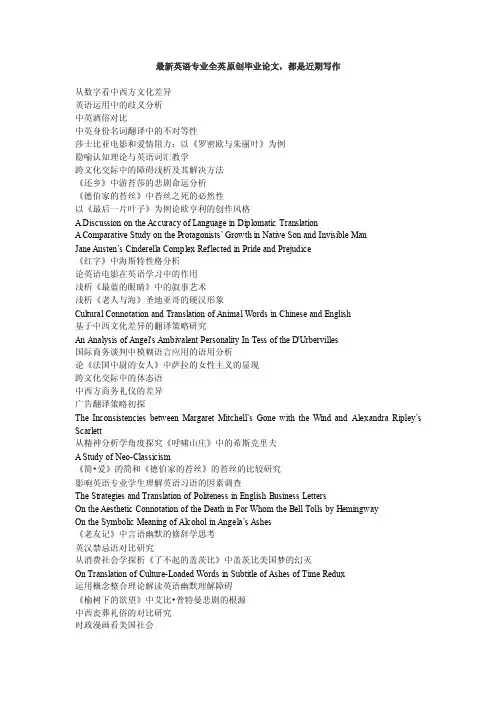
最新英语专业全英原创毕业论文,都是近期写作从数字看中西方文化差异英语运用中的歧义分析中英酒俗对比中英身份名词翻译中的不对等性莎士比亚电影和爱情阻力:以《罗密欧与朱丽叶》为例隐喻认知理论与英语词汇教学跨文化交际中的障碍浅析及其解决方法《还乡》中游苔莎的悲剧命运分析《德伯家的苔丝》中苔丝之死的必然性以《最后一片叶子》为例论欧亨利的创作风格A Discussion on the Accuracy of Language in Diplomatic TranslationA Compara tive Study on the Protagonists’ Growth in Native Son and Invisible ManJane Austen’s Cinderella Complex Reflected in Pride and Prejudice《红字》中海斯特性格分析论英语电影在英语学习中的作用浅析《最蓝的眼睛》中的叙事艺术浅析《老人与海》圣地亚哥的硬汉形象Cultural Connotation and Translation of Animal Words in Chinese and English基于中西文化差异的翻译策略研究An Analysis of Angel's Ambivalent Personality In Tess of the D'Urbervilles国际商务谈判中模糊语言应用的语用分析论《法国中尉的女人》中萨拉的女性主义的显现跨文化交际中的体态语中西方商务礼仪的差异广告翻译策略初探The Inconsistencies between Margaret Mitchell’s Gone with the Wind and Alexandra Ripley’s Scarlett从精神分析学角度探究《呼啸山庄》中的希斯克里夫A Study of Neo-Classicism《简•爱》的简和《德伯家的苔丝》的苔丝的比较研究影响英语专业学生理解英语习语的因素调查The Strategies and Translation of Politeness in English Business LettersOn the Aesthetic Connotation of the Death in For Whom the Bell Tolls by HemingwayOn the Symbolic Meaning of Alcohol in Angela’s Ashes《老友记》中言语幽默的修辞学思考英汉禁忌语对比研究从消费社会学探析《了不起的盖茨比》中盖茨比美国梦的幻灭On Translation of Culture-Loaded Words in Subtitle of Ashes of Time Redux运用概念整合理论解读英语幽默理解障碍《榆树下的欲望》中艾比•普特曼悲剧的根源中西丧葬礼俗的对比研究时政漫画看美国社会对高中学生英语学习动机现状及激发策略的调查分析—以屏边高级中学为例Translation Strategies about V acant Words in Dreams of the Red Mansion从功能对等理论来看委婉语翻译成功智力理论对英语素质教育的启示“金玉良缘”与“幸福终点”——浅析中西婚姻差异英美小说《傲慢与偏见》和《飘》中的女性主体意识比较分析文化语境对翻译的影响英语环境的营造对中学生英语学习的影响英汉颜色词的文化差异及其翻译浅析合作原则在汉英广告语翻译中的运用浅谈故事在小学英语教学中的运用交际法在中学英语词汇教学的应用《太阳照常升起》中科恩屡遭排斥的根源分析《霍乱时期的爱情》中象征手法的解析构建和谐社会——以美籍黑人的种族歧视为例论乔治•艾略特《亚当•比德》中的道德冲突论英汉习语中的动物文化浅析科技英语翻译中的逻辑错误The Westernization of Chinese Wedding中西悼亡诗看中西文化高中英语听、说、读教学活动中写作融入模式的初探Negative Transfer and the Errors Committed by Chinese English LearnersOn House’s Model for Translation Quality Assessment——A Case Study of Li Mi’s Chen Qing Biao《红字》中的丁梅斯代尔和齐灵渥斯谁更“恶”?论《白鲸》主角的悲剧实质The Elementary Stage Translation Teaching Design for Undergraduate English Majors关键词法在英语词汇学习中的效果研究透过《傲慢与偏见》中四位女性的性格分析她们的不同婚姻从个人英雄主义角度解读《肖申克的救赎》顺应论视野下茶文化负载词的英译策略奈达功能对等理论指导下英汉广告修辞的翻译策略探究评《傲慢与偏见》中卢卡斯小姐新闻英语文体分析从文化角度看英语习语的翻译从《嘉莉妹妹》看美国梦与道德观中西方酒类广告的文化互文性研究宗教禁欲下的爱情-论霍桑的宗教观与道德观在《红字》中的体现对乔治艾略特作品中的独特女性意识的研究——以《米德尔马契》为例笛福《鲁宾逊漂流记》中鲁宾逊形象解析探析《红字》中齐灵渥斯的恶中之善影响英语课堂合作学习有效性的因素分析及其对策英语专业全英原创毕业论文,是近期写作,公布的题目可以用于免费参考(贡献者ID 有提示)《嘉莉妹妹》中男女主人公命运的对比分析A Contrastive Study on Traditional Festivals in Chinese and Western Cultures—from the Perspective of the Disparity between Spring Festival and Christmas Day“美国梦”的再探讨—以《推销员之死》为例《我的安东妮娅》中的文化冲突研究A Researc h on University Students’ L Learning Motivation汉英语序对比浅析绽放在“金字塔”上的玫瑰---《纯真年代》主要女性角色分析从翻译目的论看归化异化的互补性美国广告语中的会话含义研究Some Writing Skills for Senior High School Students in NMET《小王子》中的象征意蕴的分析A Probe into the Spiritual Worlds of The Old Man and the SeaSino-American Business Negotiations:An Intercultural Communication Perspective融入与挑战--从生态角度看《老人与海》与《瓦尔登湖》中英花卉隐喻下的情感叙事对比研究The Joy Luck Club :Chinese Mothers’American Dreams Lost and Regained中美电影文化营销的比较研究浅析英语粘着词素及其在词汇教学中的实用价值从童话看中西方儿童教育的差异从英汉动物成语比较中英文化差异英汉亲昵称谓语的语用及认知对比研究浅析中学英语教学中教师如何“纠错”浅析英汉语言中颜色词的运用The Analysis of Promotion Strategy of L’Oréal in China寻找女性的自我—评托妮莫里森作品《秀拉》中秀拉形象从功能对等理论角度看校训的汉英翻译原则剖析《所罗门之歌》中的黑人意识《小镇畸人》中的空间形式分析从中英语言中的幽默表达看中西方思维差异中国茶文化与西方咖啡文化的对比分析现代社会的荒诞性——从黑色幽默解读《毛猿》通过《荆棘鸟》来探究考琳麦卡洛的内心世界李清照词英译研究Psychological Analysis of Stuttering in The King’s Speech《推销员之死》中男主人公悲剧命运分析从生态批评的视角看《远离尘嚣》的生态悖论An Archetypal Study of J.D.Salinger’s The Catcher in the Rye论模糊限制语在广告中的语用功能态度系统的评价价值--以小说《傲慢与偏见》例张爱玲与简奥斯汀的讽刺艺术比较基于语义场理论的高中英语词汇教学策略任务型语言教学在高中英语课堂中的应用从功能理论角度分析电影《点球成金》字幕翻译论英语俚语的汉译—以奈达的功能对等理论为指导从归化与异化角度浅析《毛泽东选集》英译本中文化负载词的翻译《远大前程》和《了不起的盖茨比》中悲剧英雄的伟大之处对比狄金森、席慕蓉爱情诗中隐喻现象对比研究英语电影的中文名称翻译探究马克吐温的反奴隶制观—对《哈克贝利费恩历险记》中吉姆的分析合作学习在高中英语写作教学中的应用对于高中生英语学习感知风格的调查研究文学课程中的文化导入The Translation of Advertisements探究英语双关语在广告中的应用A Brief Analysis of Public Sign Translation白鲸中的自传元素公共标识翻译的跨文化语用学研究An Analysis of Survival of Orphans in Oliver Twist《十日谈》中的乡村意象英汉社交称谓语的对比研究美国电影作品中英雄主义所隐含的美国社会文化Analysis of the Individual Heroism in the American Movies浅析英汉基本颜色词之文化内涵--以“白”与“黑”为例The Degeneration of the Human Nature in Wuthering HeightsOn Translation of Humorous Language from English to ChineseNonverbal Communication Used in Different English Teaching Stages英汉颜色词“红”与“白”的文化内涵研究英语基本味觉词“甜/苦”的隐喻机制从二十世纪英国女装造型看女性主义思想对女性地位的影响An Analysis of Imprisonment and Liberation in Great Expectations《远大前程》中皮普成长的心路历程试比较《汤姆索亚历险记》与《哈克贝利芬历险记》中主人公性格异同点从《人生的枷锁》中三个女性看毛姆的婚爱观Gothic Romance: Inheritance and Development of Medieval Romance--A Case Study of The Castle of Otranto跨文化视角下中西方选秀文化对比研究——以达人秀为例《还乡》中游苔莎的悲剧命运分析以名词动用为例分析英语词汇学习中的隐喻从《成长的烦恼》和《家有儿女》的对比看中西方家庭价值观的差异中西方节日文化差异研究浅析女性主义在薇拉﹒凯瑟作品中的表现英汉语中恐惧隐喻的认知分析浅析英语谚语中的性别歧视Aesthetic Arts in Allan Poe’s Poetry—An Analysis of Israfel and Annabel Lee中西方茶文化对比研究——以红茶为例The Otherization of China in The Woman Warrior从文化视角考察中英语言的称谓语差异英语专业全英原创毕业论文,是近期写作,公布的题目可以用于免费参考(贡献者ID 有提示)新闻英语标题的特点和翻译从交际翻译视角看企业简介的汉英翻译红字中的象征意义《沙漠之花》的女性主义研究悲剧英雄—赫尔曼梅尔维尔笔下的比利巴德形象分析论《百舌鸟之死》中的百舌鸟象征浅论《查泰莱夫人的情人》中的女权主义On Michael Moore's Fahrenheit / From the Rhetoric Perspective从《嘉莉妹妹》看本性与理性的斗争On the Use of Satire and Humor in Pygmalion《飘》的成长主题解读A Reflection upon American Heroism Based on Reviews of Hollywood Movies交际法在中学英语教学中的运用Cultural Difference between Chinese and English on Politeness唐诗意象英译中的文化障碍和策略《吉檀迦利》中的泛神论思想“土生子”叛逆精神探源Analysis on Moon Image in Lawrence’s Novels------Industrialism and Chauvinism高中英语写作前口语活动设计与实施建议英汉语篇衔接手段对比研究——以《荷塘月色》英译本为例电影字幕汉译的归化与异化英国足球对中国足球发展的启示《大衣》中定语从句的翻译策略论詹姆斯乔伊斯《阿拉比》的精神顿悟论杰克伦敦的个人经历和信仰对《野性的呼唤》主人公巴克命运的影响模因论指导下的英语习语汉译从文化差异角度研究英文新闻标题翻译的策略论英语中的矛盾修辞中西方文化差异对广告翻译的影响目的论指导下的英文影视名称的翻译。
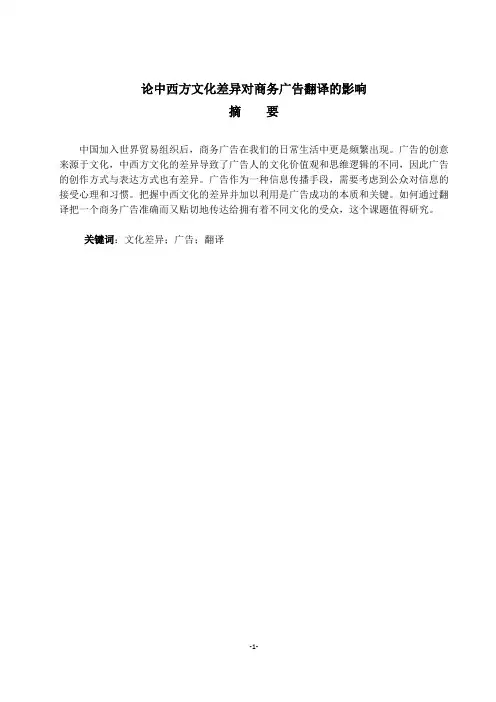
论中西方文化差异对商务广告翻译的影响摘要中国加入世界贸易组织后,商务广告在我们的日常生活中更是频繁出现。
广告的创意来源于文化,中西方文化的差异导致了广告人的文化价值观和思维逻辑的不同,因此广告的创作方式与表达方式也有差异。
广告作为一种信息传播手段,需要考虑到公众对信息的接受心理和习惯。
把握中西文化的差异并加以利用是广告成功的本质和关键。
如何通过翻译把一个商务广告准确而又贴切地传达给拥有着不同文化的受众,这个课题值得研究。
关键词:文化差异;广告;翻译On Cultural Differences in Advertisement TranslationAbstractWe are embraced by all kinds of commercial advertisements in our daily life since China has entered into the WTO. The idea of an advertisement comes from culture, so the culture difference may lead to different cultural values among different advertisements. As a widely used medium of communication in modern society, an advertisement needs to take the cultural differences into consideration. How to communicate a commercial advertisement to people of different cultural backgrounds correctly and appropriately deserves to be investigated.Key words: cultural difference; advertisement; translation.On Cultural Differences in Advertisement Translation论中西方文化差异对商务广告翻译的影响1. IntroductionThere is more and more acute marketing competition today. Under this circumstance, an advertisement of good quality will be necessary if you want to make your products competitive and attractive to the consumers among millions of other competitors. Besides, a successful advertisement is also a very important part in world-wide business.Chinese economy has already melted into the world market.A good translated advertisement will not only convey the information in accuracy and reap a good advertising effect, but also stimulate receptor’s cultural and appreciating association, which will be of much help to the cultural communication, thus it is also an impulse in cultural diffusion.We can't deny that most of the private enterprises haven’t realized how to create an English advertisement and searched for help from an inexpert translator instead of professional agency. This leads to a poor quality of the advertisement translation. Some of the translation principals know little about English; therefore the quality of the translated advertisement will not be assured. Many translators do a very poor job with various intolerable mistakes.With the development of economy, trans-national advertising will become more and more frequent. Therefore, successful advertising language must be able to impress people and create a lasting and strong memory in people’s mind. Writers and translators of advertisements should pay attention to the features of advertising language, cultural differences and translation principles.This article mainly focuses on the influence of advertisement translation due to the cultural differences between China and western countries and what we should do if we are dealing with an advertisement translation job.2. The Overview of an Advertisement.In this section, I will mainly focus on the topic about the functions, the features and the standards of an advertisement. How to classify so many kinds of advertisements will be mentioned too.2.1 The definition of an advertisementThe word “advertise” stems from the Latin “advertere”,meaning “to make known to the public”.We live in a world full of advertisements. What on earth is an advertisement?One of the famous definitions is that “An advertisement is a message or an announcement that informs or influences people. It can use words, pictures, music or film to convey its message. Advertisements are not only made and paid for by business, but also by individuals, organizations and associations that wish to inform or educate the public.”①The other one is that “Advertisement is a form of communication intended to promote the sale of a product or service, to influence public opinion, to gain political support, to advance a particular cause, or to elicit some other response desired by the advertiser... Advertisement is distinguished from other forms of communication in that the advertiser pays the media to deliver the message.”(Encyclopedia Britannica, Volume I, 1994),2.2 The functions of an advertisementThey tell people about new products and help promote sales.②:95They provide us with a good collection of goods and service, from which we can make our best choices.②:95Advertisement bridges markets, products and consumers together. It can help the consumers to identify and differentiate products and build brand preference and loyalty.②:95 Advertising has to create new demands and they should educate the people about more and more new things coming up in the market.And another important function of an advertisement is the identification function, that is, to identify a product and differentiate it from others. This creates an awareness of the product and provides a basis for consumers to choose the advertised product over other products.2.3 How do we classify so many kinds of advertisementsAdvertisement can be classified by medium (newspaper, TV, magazine, etc)Advertisement can be classified by target audience (consumer, business)Advertisement can be classified by purpose (profitable, non-profitable)2.4 The features of advertising languageThe language of advertisement should be clear and easy to understand in general. There are some distinct features of advertisement.(1) Puns are widely used in advertisement, such as homophonic puns or grammar puns;(2) Using adjectives and adverbs in Hyperbole-exaggeration;(3) Using a limited range of evaluative adjectives including new, clean, white, real, fresh, right, natural, big, great, slim, soft, wholesome, improved, etc.;(4) Influencing the readers by using short sentences. This influence is especially clear at the beginning of a text, often using bold or large type for the “h eadline” or “slogan” to capture the attention of the reader;(5) Being humor. This can be verbal or visual, but aim at showing the product positively;(6) Simple and Colloquial language;Example 1:“It ain't half good”This advertisement appeals to ordinary people, though it is in fact often complex and deliberately ambiguous.(7) Present tense is used most commonly, though nostalgia is summoned by the simple past.(8) Long noun phrases, frequent use of suffix and prefix for descriptions.(9) Use Imperative, such as “Buy Brown's Boots Now!”③:212.5 The standards of a good advertising translationA good advertisement translation is one that reproduces the effect as closely as possible.A good advertisement translation is one that elicits the desire of the consumers to buy things. There are some basic standards for a good advertising translation:It should contain the original spirit.It should be easy to be understood.It should be vivid and persuasive.3. Cultural Differences in Advertisement TranslationThe target of advertisement writer is the native reader who has same values, thinking ways and living habits, so the advertisement translator needs to face the people whose cultural background, tradition and social values are utterly different. Therefore, as an intercultural activity, advertisement translation requires the translator to put acceptance degree of target reader in the first place and to consider adequately the specific details of a culture in advertisement.Advertisement can influence people’s values, traditions and customs.We don’t need to worry about the cultur al difference in our own country while we are making an advertisement. We Chinese people underestimate the communication situation when we prepare for readers, listeners, or viewers from western countries somehow.A qualified advertisement translator should know clearly about the cultural differences, thus, he or she could be able to make a good advertisement and arouse the customers’ purchasing desire.In this section, I will focus on 6 aspects to illustrate the influence of cultural differences on advertisement translation as follows:The different values can influence advertisement translation.The different social background can influence advertisement translation.The different traditions and customs can influence advertisement translation.The different taste for beauty can influence advertisement translation.The different courteous principle can influence advertisement translation.The different ways of thinking can influence advertisement translation.3.1 The different values can influence advertisement translation.Every country has its own cultural values. What advertisers and translators should do is to make the advertisement consistent with values of the targeted people. If not, they are likely to be rejected.There are lots of different values. For example, worshipping the individualism is a typical value of western countries. We can see it very often in western advertisements.In western countries, people pursue independence. Everyone tends to be independent. Everyone is unique (why should I do the same as others?). So advertisements there never advocate people to follow the public to show admiration to the so-called authority people. What is reflected in the advertisement are “individuality”, “independence” and “privacy”.Example 1: “obey your thirst-spirit” (服从你的渴望). “impossible made possible” (使不可能成为可能).③:21Example 2: “孔府家酒,叫人想家”Chinese people put more emphasis on collectivism while western countries value individualism more. From this advertisement we can see the typical spirit of Chinese people.Example 3: Western countries value the spirit of innovation while Chinese people follow the spirit of mediocracy. And p eople in western countries don’t feel like run ning only in one groove. Take the slogan of Apple as an example: Apple thinks different(苹果电脑,不同“凡”想).③:213.2 The different social history background can influence advertisement translation.Western people treat the official position as the very common thing. Western culture pays more attention to the personal value and self interest. It may lead to the dissimilarity in advertising translation. Just look at these following examples of brand name translation in advertisement translation.Example 4: Western people treat the official position as a pretty common thing. Western culture pays more attention on the personal value and personal interests. Such as the trade mark “白熊”. There are two versions of translation: “p olar bear” and “white bear”. Which one is better? This is something related to politics. “Polar bear” ha s another meaning in the political field in western countries, so people could get confused easily. In this case, “white bear” would be a better choice.④:195Example 5: “金龙食用油,绿色的食用油”Dragon is definitely a sign of lucky and fortune in China, but in western countries it is just an evil creature, so this is so inappropriate if you translate the brand name “金龙”to “golden dragon”.Example 6: Southern Comfort— the spirit of New Orleans since 1860.Actually, this advertisement is total a success in America because it relies on native people’s un derstanding of American traditional culture. “Southern Comfort” wine just like the American Jazz all comes from New Orleans. Due to the cultural identity, we can easily figure out its pun meaning which means a lot in a good advertisement translation. “Southern Comfort” wine has become widely familiar in America from middle period of 19th century when people began to create Jazz music. It presents the spirit of New Orleans somehow-deploitation, innovation and optimism. However, due to the lack of related cultural background, it is hard for Chinese reader to perceive cultural connotation in the original text. So, the translation should be based on Chinese audience’s point of view an d mainly focus on cultural apprehension.Example 7: “Fresh Up with Seven-Up” (七喜广告语)Numbers in an advertisement is an important factor that we should pay much attention to.The word seven is a positive word in these areas: America and Europe. Seven is equal to the number eight in China which stands for a good luck.3.3 The different traditions and customs can influence advertisement translation.It is well known that if you want to learn a foreign language you should get to know the local traditions and customs first. The influence of traditions and customs is so obvious in people’s daily life. For example, every language and corresponding cultural system contains specific constrains in speech such as taboo words. We should pay attention to this aspect.Example 8: Take the word “lady” as an example, you never translate the word “lady” in an English advertisement into “小姐”cause “小姐”is a taboo word in China.④:196 Example 9:金鸡鞋油(Golden Rooster shoes polish)In this example Rooster can not be replaced by the word “cock”, because “cock”has another meaning in English slang which is also a taboo word.④:1963.4 The different taste for beauty can influence advertisement translation.The word “aesthetic” means the taste for beauty.To reach elegance in sound, appearance and meaning, Chinese advertisement language tends to use lots of couplet, parallel structure or four-character structure. You have to admit that this has something related to the unique aesthetic of Chinese people. Just look at this advertisement below.Example 10:A divorced man advertises an advertisement like this: “寻寻觅觅,韶华转眼飞逝;犹犹豫豫,知音再度难逢”. “寻寻”and “觅觅”and “犹犹”and “豫豫”do have the same meaning. They sound good in rhyme and are natural and harmonious in meaning. While In English, “synonyms repetition” is always avoided. Thus the translation would be better if we erase the unnecessary words.From the aesthetic perspective, symbolizing the beauty and shaping beautiful characters can help people shape a better psychological reaction and visual effects.Example 11: “Coca-Cola” is translated to“可口可乐”.Example 12: “Cola Cao” is translated to“高乐高”.Example 13: “Clean C lear” is translated to“可伶可俐”.Example 14: “C olgate” is translated to“高露洁”.Example 15: We often see that“增白”is translated into“white the skin” in Chinese skin care product.“增白”is a commendatory term in China. However, in western countries, people believe white is not beauty. “White” means poor ness and sickness. From this example we can see that different aesthetic means a lot to advertisement translation.④:1973.5 The different courteous principles can influence advertisement translation.Courtesy is the common conducting norm for people to act or communicate in a more appropriate way in public. Harsh tone is not so easy for people to accept.Example 16: In China, public advertisements often start with “禁止...”(“Do Not (i)English). Such as “Do not pick the flower” and “Do not Pee around”. These two stiff and harsh slogans are a commanding tone. People from western countries will feel offended so easily and it will not help anyway. They believe they are not getting enough respect from these kinds of slogans.To change “Do not pick the flower” into a mild er slogan “Take care of those dedicate flowers, please” would be great because it arouses people’s sympathy for them.3.6 Different ways of thinking can influence advertisement translation.People have different ways of thinking or reasoning due to different cultures. If we do not pay attention to this, it may cause a misunderstanding in advertisement translation.Example 17: “开袋即食,食用方便。
